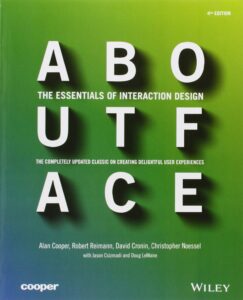“If we want users to like our software we should design it to behave like a likeable person: respectful, generous and helpful.”
Biography
“The user as a starting point”
Alan Cooper began to take an interest in programming during his college years, to pay for his studies in Architecture.
At the end of these and in 1975 with the release of the first personal computers (at that time, still under the name of microcomputers), he founded his first software development company.
He quickly realizes that the development methodology of the time (then accepted by all) by engineers, for engineers, does not correspond to the reality of the need. According to him, the engineers' question "How can this service be coded?" misses the real problem which is rather “how will the end users interact with the solution?”.
From this reflection and his experience as a consultant to software designers, a methodology will quickly emerge that puts user needs back at the center of concerns. He refines this new method by interviewing end users in order to understand their expectations and identify the common discussion topics that make these people happy. This is the birth of personas as design tools.
It will also be the starting point of the user experience movement (the “user experience” strictly speaking), which he will largely contribute to developing so that it becomes the current of “interaction design”.
“Language learning”
At the same time, he developed his first programming language CBASIC, then a competitor to BASIC, developed by a certain Bill Gates and his friend Paul Allen.
In 1988, after having proven himself in software programming, having multiplied his experiences and experiencing success in the B to B field, he developed the Ruby language, which was bought by Microsoft. This same language will then be marketed under the name of Visual Basics by the firm but diverted from its original format intended for users to make it a programming tool intended for professionals and which will subsequently become the programming base for a large part of the Windows universe.
This language allows, among other things, the rapid development of applications or the creation of graphical user interfaces (find out more about Visual Basics here)
Much later, in 1994, Bill Gates personally awarded Cooper the first “Windows Pioneer Award” for his overall contribution to the software industry.
In 1998, he was also awarded the prestigious Visionary Awards of the SVForum.
Cooper is now the president of his own company Cooper, which provides training and supports companies in their interaction design challenge. He is also interested in how best to integrate advances in interaction design into Agile development methods.
Contributions in the field ofUX
Publications
[testimonial] “Interaction design isn't merely a matter of aesthetic choice; rather, it is based on an understanding of users and cognitive principles.”[/ testimonial]
 First published in 1995, it is now in its third reissue (About Face 3). It is the result of Alan Cooper's early thoughts and ideas around the end user as the starting point for interaction design. It is still today a benchmark in the design movement of the same name.
First published in 1995, it is now in its third reissue (About Face 3). It is the result of Alan Cooper's early thoughts and ideas around the end user as the starting point for interaction design. It is still today a benchmark in the design movement of the same name.[testimonial]“Computers no longer interface with humans–they interact, and the interaction will become progressively deeper, more subtle, and more crucial to our collective health and ultimate survival.”[/ testimonial]
 In 1999, Cooper tackled the subject of Man/Machine interactions in this book, the central theme of which was the concept of “cognitive friction”. What he himself defines as “the resistance encountered by the human intellect when confronted with a complex system of rules which change as the problem evolves”.
In 1999, Cooper tackled the subject of Man/Machine interactions in this book, the central theme of which was the concept of “cognitive friction”. What he himself defines as “the resistance encountered by the human intellect when confronted with a complex system of rules which change as the problem evolves”.
Concepts and Notions
- Personas
In the 1990s, Cooper developed a design methodology based on interviews with end users of a service or software in order to define their main expectations and the common topics of discussion that made these people happy. All the details then collected are put together to form the character of a typical potential user taken as a model when designing an interface or a service.
Personas are widely used as a tool in interaction design.
- Visual Basics
Alan Cooper is recognized today as being the father of the visual basics programming language which was used in the majority of windows applications and contributed to the success of the giant Microsoft.
“No matter how cool your interface is, the less of it would be better.”
Quentin BOUISSOU – UX-Evangelist @UX-Republic
STORYTELLING: THE ART OF CONVINCING # Paris
SMILE Paris
163 quay of Doctor Dervaux 92600 Asnières-sur-Seine
UX/UI ECO-DESIGN # Paris
SMILE Paris
163 quay of Doctor Dervaux 92600 Asnières-sur-Seine
DESIGN THINKING: CREATING INNOVATION # Belgium
UX-REPUBLIC Belgium
12 avenue de Broqueville - 1150 Woluwe-Saint-Pierre
MANAGING AND MEASURING UX # Paris
SMILE Paris
163 quay of Doctor Dervaux 92600 Asnières-sur-Seine
DESIGN SPRINT: INITIATION & FACILITATION # Paris
SMILE Paris
163 quay of Doctor Dervaux 92600 Asnières-sur-Seine
UX-DESIGN: THE FUNDAMENTALS # Belgium
UX-REPUBLIC Belgium
12 avenue de Broqueville - 1150 Woluwe-Saint-Pierre
GOOGLE ANALYTICS 4 #Paris
SMILE Paris
163 quay of Doctor Dervaux 92600 Asnières-sur-Seine
ACCESSIBLE UX/UI DESIGN # Belgium
UX-REPUBLIC Belgium
12 avenue de Broqueville - 1150 Woluwe-Saint-Pierre













